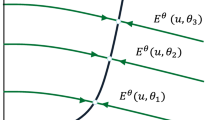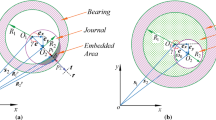Abstract
Although it is known from previous studies that porpoising in high-speed planing craft is a Hopf bifurcation, this study examined its occurrence and disappearance using the motion model identified from full-scale test data. Herein, we first analyzed the stability of the system linearized near the equilibrium point. From its results, we reconfirmed the knowledge that porpoising occurs when the system becomes unstable in the vicinity of the equilibrium point. We also found that the system became unstable as the thrust or trim angle of the outboard motor decreased. This finding was consistent with the results of a full-scale craft test performed in a previous study. Second, we confirmed that the limit cycle which is a result of the nonlinearity of the system was stable. The two analyses indicate that porpoising corresponds to the supercritical Hopf bifurcation. Furthermore, in the vicinity of the bifurcation point, it was found that stable equilibrium points and stable limit cycles can coexist. Finally, we confirmed this phenomenon in the full-scale test.











Similar content being viewed by others
References
National Marine Manufactures Association, 2020 powerboat sales trends. Tech. rep., National Marine Manufactures Association (2021). https://www.nmma.org/statistics/publications/statistical-abstract. Access at 26 Jan 2022
Hicks JD, Troesch AW, Jiang C (1995) Simulation and nonlinear dynamics analysis of planing hulls. J Offshore Mech Arct Eng 117(1):38
Savitsky D (1964) Hydrodynamic design of planing hulls. Marine Technol SNAME News 1(04):71
Day JP, Haag RJ (1952) Planing Boat Porpoising. Thesis, Webb Institute of Naval Architecture
Brown PW (1971) An experimental and theoretical study of planing surfaces with trim flaps, Stevens Institute of Technology, Davidson Laboratory, Hoboken, New Jersey, USA, Report No. SIT-DL-71-1463
Ekman F, Rydelius F (2016) Model for Predicting Resistance and Running Attitude of High-Speed Craft Equipped with Interceptors : A comparative study including validation on Swedish Coast Guard patrol boat KBV 315
Katayama T (2004) Mechanism of porpoising instabilities for high-speed planing craft. In The Sixth ISOPE Pacific/Asia Offshore Mechanics Symposium (OnePetro)
Sun H, Faltinsen O (2007) Porpoising and dynamic behavior of planing vessels in calm water, 9th International Conference on Fast Sea Transportation, FAST 2007 pp. 396–404
Sun H, Faltinsen O (2011) Predictions of porpoising inception for planing vessels. J Mar Sci Technol 16:270
Zan L, Sun H, Lu S, Zou J, Wan L (2023) Experimental study on porpoising of a high-speed planing trimaran. J Mar Sci Eng. https://doi.org/10.3390/jmse11040769
Kim SW, Seo KC, Lee DK, Lee GW (2017) A numerical study on dynamic instability motion control of wave-piercing high-speed planing craft in calm water using side appendages. J Korean Soc Mar Environ 23(3):320
Sajedi SM, Ghadimi P, Sheikholeslami M, Ghassemi MA (2019) Experimental and numerical analyses of wedge effects on the rooster tail and porpoising phenomenon of a high-speed planing craft in calm water. Proc Inst Mech Eng C J Mech Eng Sci 233(13):4637
Troesch AW, Falzarano JM (1993) Modern nonlinear dynamical analysis of vertical plane motion of planing hulls. J Ship Res 37(03):189
Hassard BD, Kazarinoff ND, Wan YH (1981) Theory and applications of Hopf bifurcation, vol 41. CUP Archive
Troesch AW (1992) On the hydrodynamics of vertically oscillating planing hulls. J Ship Res 36(04):317
Katayama T, Taniguchi T, Habara K (2011) Tank tests to estimate the onset of dynamic instabilities of high-speed planing craft. Trans Soc Naval Archit Mar Eng 118:106
Hamada S, Miyauchi Y, Umeda N, Maki A (2022) 2022A-OS1-8 System identification of High Speed Planing Craft Using Full Scale Trial Data. Conference Proceedings The Japan Society of Naval Architects and Ocean Engineers 35:67
Hamada S, Miyauchi Y, Akimoto Y, Umeda N, Maki A (2023) System identification of porpoising dynamics of high-speed planing craft using full scale trial data. Ocean Eng 270:113585
Kawakami H, Matsumura T, Kobayashi K (1978) An algorithm to obtain the periodic solutions on autonomous systems. Trans Inst Elec Comm Eng Jpn 69(9):1051
Kawakami H (1984) Bifurcation of periodic responses in forced dynamic nonlinear circuits: computation of bifurcation values of the system parameters. IEEE Trans Circuits Syst 31(3):248
Tsumoto K, Ueta T, Yoshinaga T, Kawakami H (2012) Bifurcation analyses of nonlinear dynamical systems: from theory to numerical computations. Nonlinear Theory Appl IEICE 3(4):458
Maki A, Miino Y, Umeda N, Sakai M, Ueta T, Kawakami H (2022) Nonlinear dynamics of ship capsizing at sea. Nonlinear Theory Appl IEICE 13(1):2
Kuznetsov YA (1998) Elements of applied bifurcation theory, vol 112. Springer
Acknowledgements
The authors would like to thank the referees for their detailed comments, helpful advice, and suggestions. Experiments for this study were conducted by Mr. Yasushi Iriono of Yamaha Motor Co., LTD. We would like to express our gratitude to Professor Naoya Umeda of Osaka University, Professor Toru Katayama of Osaka Metropolitan University and Professor Hiroyuki Kajiwara of Nagasaki Institute of Applied Science for their helpful discussions. We also thank Mr. Akihiro Onoue, Mr. Toshio Suzuki, Mr. Masaru Suemori, Mr. Yoshiyuki Kadobayashi, Mr. Shintarou Futagwa of Yamaha Motor Co., LTD., and Ms. Manami Oyama of YAMAHA MOTOR ENGINEERING CO., LTD. for continuous discussions. We are grateful to Enago (http://www.enago.jp) for reviewing the English language.
Author information
Authors and Affiliations
Corresponding author
Ethics declarations
Conflict of interest
The authors declare that they have no conflict of interest.
Additional information
Publisher's Note
Springer Nature remains neutral with regard to jurisdictional claims in published maps and institutional affiliations.
About this article
Cite this article
Hamada, S., Maki, A. Linear and nonlinear analyses of the porpoising dynamics of high-speed planing craft using full-scale trial data. J Mar Sci Technol 29, 93–104 (2024). https://doi.org/10.1007/s00773-023-00972-3
Received:
Accepted:
Published:
Issue Date:
DOI: https://doi.org/10.1007/s00773-023-00972-3




